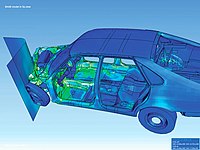
Photo from wikipedia
The boundary element method (BEM) is a powerful tool in computational acoustics, because the analysis is conducted only on structural surfaces, compared to the finite element method (FEM) which resorts… Click to show full abstract
The boundary element method (BEM) is a powerful tool in computational acoustics, because the analysis is conducted only on structural surfaces, compared to the finite element method (FEM) which resorts to special techniques to truncate infinite domains. The isogeometric boundary element method (IGABEM) is a recent progress in the category of boundary element approaches, which is inspired by the concept of isogeometric analysis (IGA) and employs the spline functions of CAD as basis functions to discretize unknown physical fields. As a boundary representation approach, IGABEM is naturally compatible with CAD and thus can directly perform numerical analysis on CAD models, avoiding the cumbersome meshing procedure in conventional FEM/BEM and eliminating the difficulty of volume parameterization in isogeometric finite element methods. The advantage of tight integration of CAD and numerical analysis in IGABEM renders it particularly attractive in the application of structural shape optimization because (1) the geometry and the analysis can be interacted, (2) remeshing with shape morphing can be avoided, and (3) an optimized solution returns a CAD geometry directly without postprocessing steps. In the present paper, we apply the IGABEM to structural shape optimization of three dimensional exterior acoustic problems, fully exploiting the strength of IGABEM in addressing infinite domain problems and integrating CAD and numerical analysis. We employ the Burton–Miller formulation to overcome fictitious frequency problems, in which hyper-singular integrals are evaluated explicitly. The gradient-based optimizer is adopted and shape sensitivity analysis is conducted with implicit differentiation methods. The design variables are set to be the positions of control points which directly determine the shape of structures. Finally, numerical examples are provided to verify the algorithm.
Journal Title: Computer Methods in Applied Mechanics and Engineering
Year Published: 2019
Link to full text (if available)
Share on Social Media: Sign Up to like & get
recommendations!